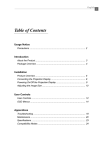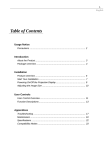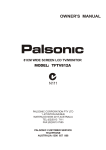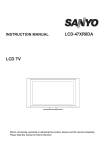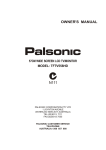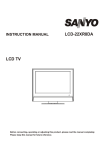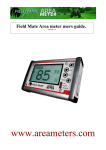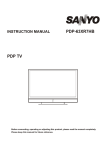Download Optoma Technology EP550 User's Manual
Transcript
2 English Table of Contents Usage Notice Precautions ............................................................................................. 3 Introduction About the Product .................................................................................... 4 Package Overview .................................................................................. 5 Installation Product Overview .................................................................................... 6 Start Your Installation ............................................................................... 8 User Controls User Control Overview ............................................................................ 10 Function Descriptions .............................................................................. 13 Appendices Troubleshooting ....................................................................................... 16 The Apple Macintosh Connections ......................................................... 18 Maintenance ............................................................................................ 19 Specifications .......................................................................................... 21 Compatibility Modes ................................................................................ 22 3 English Usage Notice Warning- Do not look into the lens. The bright light may hurt your eyes. Warning- To reduce the risk of fire or electric shock, do not expose this product to rain or moisture. Warning- Please do not open or disassemble the product as this may cause electric shock. Warning- When changing the lamp, please allow unit to cool down, and follow all changing directions. Warning- If the cooling fan is not working, switch off the power immediately. The product will be overheated without ventilation. Warning- Before switching off the product, please keep the cooling fan running for a few minutes. Precautions Follow all warnings, precautions and maintenance as recommended in this user’s manual to maximize the life of your unit. Do: q q q Turn off the product before cleaning. Use a soft cloth moistened with mild detergent to clean the display housing. Disconnect the power plug from AC outlet if the product is not used for a long period of time. Don’t: q q q Block the slots and openings on the unit provided for ventilation. Use abrasive cleaners, waxes or solvents for your cleaning. Under the following conditions: - Extremely hot, cold or humid environment. - Areas susceptible to excessive dust and dirt. - Near any appliance generating a strong magnetic field. - Place in direct sunlight. 4 English Introduction About the Product This product is a SVGA data/video portable projection display. The outstanding features of it are listed as follows: q 9.25 lbs (4.2 kg) lightweight compact design q Single panel 6.4” TFT LCD projection system q 800 x 600 SVGA addressable pixels q Compression for 1024 x 768 XGA computer image q 16.7M (24-bit) displayable colors q XGA/ SVGA/ VGA/ VESA/ Mac/ NEC PC-98/ Fujitsu FM Towns compatible q NTSC/ NTSC 4.43/ PAL/ SECAM composite video & S-Video q Multifunction presentation & image control q Multilingual OSD menu adjustments q Built-in multimedia audio q Advanced functions-keystone correction/ zoom/ freeze/ curtain/ pointer 5 English Package Overview This projection display comes with all the items shown below. Check to make sure your unit is complete. Contact your dealer immediately if anything is missing. LCD Projection Display User’s Manual S-Video Cable Carrying Case Remote Control Battery x 2 EVD Lamps x 2 Warranty Card Composite Video Cable VGA Cable Audio Cable Power Cord 6 English Installation Product Overview w Main Unit Lens Panel Control Buttons Keystone Correction Lens Latch Lamp Door Carrying Handle Elevator Foot Lamp Latch Rear Connection Ports Power Switch Power Connector Audio Outputs S-Video Connector Monitor Loopthrough Connector Computer Input Connector Composite Video Connector Fuse Audio Inputs for Video Audio Inputs for Computer 7 English w Remote Control Reset Power on/Standby POWER ON STANDBY RESET FREEZE Curtain/Color functions CURTAIN COL/TIN ZOOM OUT ZOOM IN Tracking CON/BRI TRACK SOURCE Freeze Contrast/Brightness Zoom in/Zoom out Source selection VOLUME _ + MUTE Volume Directional select keys MENU On-Screen menus ENTER POINTER Enter/Pointer Notice: For more detailed information, please refer to “Function descriptions” on page 13. 8 English Start Your Installation w Connecting the projection display Power Cord Monitor Cable Mac Monitor Adapter Mac Adapter* VGA Signal Cable Audio Cable Audio Cable Audio Cable S-Video Cable Composite Video Cable * For Macintosh, use the Mac adapter. (Refer to the Apple Macintosh Connection on page 18 for more information.) Notice: To ensure the projection display works well with your computer, please config-ure the display mode of your graphic card to make it less than or equal to 800 x 600 resolution and make sure timing of the display mode is compatible with the projection display. Refer to Compatibility Modes on page 22. 9 English w Setting up the projection display q Positioning the projection display Projection Distance Image Size (diagonal) 5 ft. (1.5 m) 6.5 ft. (2 m) 9.5 ft. (3 m) 13 ft. (4 m) 20 ft. (6 m) 40" (1.01m) 60" (1.52m) 80" (2.03m) 110" (2.79m) 160" (4.06m) (min.) (max.) (projection distance and image size) q Slide the lens latch and pop-up the projection lens. Switch on the power and press “Power on/Standby” button. (Either from the main unit or remote control) Power on/ Standby Buttons Lens Latch Power Switch q Adjusting the screen image. 1. Rotate the projection lens to focus the image. 2. Slide the keystone correction button to adjust image shape. 3. Adjust the elevation: (1) Pull out the carrying handle. (2) Lift the projection display to the desired angle. (3) Press down on the elevator node to loosen the elevator foot. Lens Keystone Correction Carrying Handle Elevator Node 10 English User Controls User Control Overview We have two ways for you to control the functions: panel control and remote control. w Panel control POWER ON STANDBY RESET MENU ENTER 4 Directional Keys w Remote control Reset Power on/Standby POWER ON STANDBY RESET FREEZE Curtain/Color functions CURTAIN COL/TIN ZOOM OUT ZOOM IN Tracking CON/BRI TRACK SOURCE Freeze Zoom in/Zoom out Source selection Contrast/Brightness VOLUME _ + MUTE Volume Directional select keys MENU On-Screen menus ENTER POINTER Enter/Pointer 11 English w OSD Menus The OSD (On-Screen Display) menus will allow you to easily adjust the display functions. Press the “MENU” button for the OSD menu options. 4 When in computer sources, the OSD will be: Language 4 When in video sources, the OSD will be: Contrast Tracking Language Frequency Contrast/Brightness Custom Memory Color/Tint Audio Audio Source Source Rear Projection Rear Projection Ceiling Projection Ceiling Projection Auto Image Exit Exit 12 English Function Descriptions w Basic Functions: 4 Power On/Standby Press the “Power On/Standby” button to turn on the projection lamp. 4 Menu Press “Menu” button to pop up the OSD menu. 4 Reset Press “Reset” to return the display parameters of the current mode to its factory default settings. 4 Enter “Enter” is used for confirming your selection. 4 Four Directional (1) Use 5or6 button to select items. Use 3or4 to make adjustments for your selection. (2) Use 5or6 button to change vertical positioning of the image; and 3or4button to change the horizontal positioning of the image. 4 Language Choose “Language” item to select your choice of English, French, German, Spanish, Italian, Japanese, and Chinese. 4 Audio (1) Volume adjustments: “+”, “-”, “Mute” (2) Audio adjustments: Bass, Treble, Balance, Volume, 4 sound modes. 4 Source Use “ Source” control to choose between video and computer source. 4 Rear Projection Choose this function from OSD menu for a rear projection. Select Keys 13 English 4 Ceiling Projection Choose this funtion from OSD menu for a ceiling mounted projection. 4 Exit Choose “Exit” item to leave OSD menu. w Presentation Functions - computer source 4 Pointer Press the “Pointer” button to show a hand shape pointer. Use5,6,3or4button to move pointer around the projected image. 4 Freeze Press the “Freeze” button to still the screen image. 4 Curtain Press “Curtain” button to cover all the screen, then use 5or6to pull up or down the curtain. 4 Zoom In/Zoom Out Press “Zoom In” button to enlarge the projected image, “Zoom Out” to resume the image. 4 Contrast Choose this function from OSD menu to adjust contrast of the image. 14 English 4 Tracking Choose “Tracking” item to synchronize the signal timing of the display to that of the graphic card. When you experience an unstable or flickering image, use this function to correct it. 4 Frequency “Frequency” is for changing the display data frequency to match the frequency of your computer’s graphic card. When you experience a vertical flickering bar, use this function to make an adjustment. 4 Custom Memory This function enables you to save your current settings for the computer source. To use this function, first choose “Custom Memory” from OSD menus, and go to the custom group you need (such as “Custom 3”), then select “Save” and press “Enter” to save your current settings; or choose “Open” and press “Enter” to load your preset settings. There are six groups of custom memories for your use. If you want to come back to RGB standard source, go to the “RGB Standard” mode located before “Custom 1” in Custom Memory OSD menus. Language Contrast Tracking Frequency Custom Memory Audio Source Rear Projection Ceiling Projection Auto Image Exit * When opening your preset custom setting, you may experience a “Invalid” message appearing on the screen. This means the computer you connected or the current setting is the wrong one, not what you preset in the projection display. * The “Reset” function of this projection display only works in RGB Standard mode. 4 Auto Image Choose “Auto Image” from OSD menus to obtain an optimum quality for your projected image. * “Auto Image” function will not support 1024 x 768 resolution. * This feature could not perform well in case of input weak signal from VGA cable. 15 English w Presentation Functions -- video source 4 Contrast/Brightness To adjust the contrast or brightness of the image, select “Contrast/Brightness” from OSD menus. 4 Color/Tint To adjust the color or tint of the image, select “Color/ Tint” from OSD menus. 4 Freeze Press the “Freeze” button to still the screen image. 16 English Appendices Troubleshooting If you are experiencing trouble with the projection display, refer to the follows. If the problem persists, please contact your local dealer or our service center. Problem: No image appears on screen. 4 Press “Power on/Standby” button. 4 Ensure all the cables and power connections are correctly and securely connected as described in the “Installation” section. 4 Ensure the pins of connectors are not crooked or broken. 4 Check if the projection lamp has securely installed. Please refer to the “Changing the lamp” section. 4 Ensure the cooling fan is on. If not, you may need to change the fuse. Please refer to the “Changing the fuse” section. Problem: Partial, scrolling or incorrectly displayed image. 4 If you are using a PC: Resolution of your computer is higher than 800x600. Follow the steps outlined below to reset the resolution. For Windows 3.x: 1. In the Windows Program Manager, click the “Windows Setup” icon in the Main group. 2. Verify that your Display resolution setting is less than or equal to 800x600. For Windows 95: 1. Open “My Computer” icon, the “Control Panel” folder, and then double click the “Display” icon. 2. Select the “Setting” tab. 3. In the “Desktop Area” you will find the resolution setting. Verify that the resolution setting is less than or equal to 800x600 resolution. If the projection display is still not projecting the whole image, you will need to also change the monitor display you are using. Refer to the following steps. 4. Follow above steps 1~2. Click on the “Change Display Type” button. 5. Select the “Change” button under the “Monitor Type” box. 17 English 6. Under “Manufacturers”, select “Standard monitor types” 7. Verify that the resolution setting of the monitor display is less than or equal to 800x600. 4 If you are using a Notebook PC: 1. You are required to implement above steps of resolution setting of computer first. 2. Switch the Notebook PC display to the “external display only” or “CRT only” mode. 4 If you are using an Apple Macintosh: Resolution of your computer is higher than that of the projection display. You may need to change the Mac adapter of 800 x 600 resolution. 4 If you are using an Apple PowerBook: Resolution of your PowerBook is higher than that of the projection display. You may need to change the Mac adapter of 800 x 600 resolution. 4 If you are experiencing difficulty in changing resolutions or your monitor freezes, restart all the equipment and the projection display. Problem: The screen of the Notebook or PowerBook computer is not displaying your presentation. 4 If you are using Notebook PC: Some Notebook PCs may deactivate their own computers’ screens when asecond display device is in use. Each of them has different way to be reactivated. Refer to your computer’s documentation for detailed information. 4 If you are using an Apple PowerBook: In Control Panels, open the PowerBook Display to select Video Mirroring “On”. Problem: Image is unstable or flickering 4 Use “Tracking” to correct it. 4 Change the monitor color setting from your computer. Problem: Image has vertical flickering bar. 4 Use “Frequency” to make an adjustment. 4 Check and reconfigure the display mode of your graphic card to make it compatible with the product. 18 English The Apple Macintosh Connections w Connecting a Macintosh Desktop Computer 4 For 640 x 480 Resolution: 1. Connect the supplied 15-pin VGA signal cable to the unit. 2. Connect the supplied MAC (VGA) adapter between the VGA signal cable and the signal output of your computer. 4 For 800 x 600 Resolution: 1. Connect the supplied 15-pin VGA signal cable to the unit. 2. Connect the supplied MAC 8x6 (SVGA) adapter between the VGA signal cable and the signal output of your computer. 3. Restart your computer. 4. In Control Panels, open the Monitors & Sound; set your Macintosh to 800 x 600 resolution. * If you cannot find any 800 x 600 resolution, please contact your Macintosh dealer. w Connecting an Apple PowerBook Computer 4 For 640 x 480 Resolution: 1. Connect the supplied 15-pin VGA signal cable to the unit. 2. Connect the supplied MAC (VGA) adapter between the VGA signal cable and the Mac external monitor cable of your PowerBook. 4 For 800 x 600 Resolution: 1. Connect the supplied 15-pin VGA signal cable to the unit. 2. Connect the supplied MAC 8x6 (SVGA) adapter between the VGA signal cable and the Mac external monitor cable of your computer. 3. Restart your PowerBook. 4. In Control Panels, open the PowerBook Display; set the number of colors; click the Monitor 2 and set your PowerBook to 800 x 600 resolution. 5. Restart the PowerBook again. * When using video mirroring and high color graphics, the projected image occasionally may turn black and white. If this happens, change the number of colors again on Monitors in the Control Panels. 19 English Maintenance w Changing the lamp Make sure the projection display has cooled for at least 30 minutes before changing the lamp. After you slide the lamp latch and open the lamp door, you will see two lamps inside; one is in “usage” position, the other is in “spare” position. Refer to the lamp changing directions below. Warning: Lamp compartment is hot! Allow it to cool before changing lamps! Lamp Changing Directions: Slide the lamp latch; open the lamp compartment. Move the lamp assembly by the long pin. Lamp Assembly Slide the lamp assembly sideways to place the spare lamp into the “usage” position. Remove the used lamp. Long Pin Lamp Door Lamp Latch “Usage” Position Hold the new lamp with a plastic bag or clean cloth and then push it firmly into the socket. (Finger oil, dust or water will damage the lamp.) Be sure the lamp assembly is set firmly back in position. Then close the lamp door. Notice: Use only USHIO or OSRAM HLX 64663T EVD 36V 400W lamp. Please contact your local supplier or service center. 20 English w Changing the fuse Fuse Holder 4 Switch off the power and unplug the power cord. 4 Pull out the fuse holder. 4 Remove the blown fuse and then insert a new fuse. 4 Put the fuse holder back in position. the Blown Fuse 21 English Specifications LCD panel - active matrix TFT color LCD - 6.4” panel x 1 - tr=30ms, tf=50ms response time - 150:1 contrast ratio Lamp - 400 watt halogen Display Resolution - 800 pixels(H) x 600 lines(V) Displayable Color - 16.7M colors Image Size - 40” to 180” diagonal Projection Distance - 5 ft. to 20 ft. / 1.5 m to 6 m Computer Compatibility - IBM & VESA VGA 640 x 350, 70/85Hz 640 x 400, 70/85Hz 720 x 400, 70/85Hz 640 x 480, 60/72/75/85Hz VESASVGA 800 x 600, 56/60/72/75Hz VESAXGA 1024 x 768 compressed, 60/70/75Hz - Apple Macintosh 640 x 480, 67Hz (Extra SVGA/ VGA mode select) - NEC PC-98 series 640 x 400, 57/70Hz 640 x 480, 60Hz - Fujitsu FM Towns 640 x 400, 55Hz 640 x 480, 60Hz Video Compatibility - NTSC/NTSC4.43/PAL/SECAM compatible - composite video & S-Video capability H. Frequency - 15kHz~60kHz horizontal scan V. Frequency - 50Hz~85Hz vertical refresh Multimedia Audio - two internal speakers with 3 watt output Power Supply - Auto switch - built-in amplifier with 3 watt x 2 output - AC input 100~120/200~240V , 50~60Hz I/O Connectors - power: AC power input socket - computer input: 15-pin D-sub 2-row connector - computer output: VGA 15-pin D-sub connector - video input: composite video RCA jack x 1 / S-Video jack x 1 - audio input: 2 pairs of L/R RCA jacks - audio output: 1 pair of L/R RCA jacks Weight - 9.25 lbs / 4.2 kg Dimensions (W x H x D) - 10.2 x 6.4 x 12.5” / 259 x 162 x 317 mm Environmental - operating temperature: 10 ~35 C/50 ~95 F o o o o humidity: 80% maximum storage temperature: o o o o -20 ~60 C/ -4 ~140 F humidity: 80% maximum Safety Regulation - FCC class A, CE Mark, VCCI-I, UL, CUL, TÜV 22 English Compatibility Modes Resolution H. Frequency (kHz) V. Frequency (Hz) IBM & VESA VGA 640 x 350 31.47 70.09 IBM & VESA VGA 640 x 350 37.86 85.08 IBM & VESA VGA 640 x 400 31.47 70.09 IBM & VESA VGA 640 x 400 37.86 85.08 IBM & VESA VGA 720 x 400 31.47 70.09 IBM & VESA VGA 720 x 400 37.93 85.04 IBM & VESA VGA 640 x 480 31.47 59.94 IBM & VESA VGA 640 x 480 37.86 72.81 IBM & VESA VGA 640 x 480 37.50 75.00 IBM & VESA VGA 640 x 480 43.27 85.00 VESA SVGA 800 x 600 35.16 56.25 VESA SVGA 800 x 600 37.88 60.32 VESA SVGA 800 x 600 48.08 72.19 VESA SVGA 800 x 600 46.88 75.00 * VESA XGA 1024 x 768 48.36 60.00 * VESA XGA 1024 x 768 56.48 70.07 * VESA XGA 1024 x 768 60.02 75.03 Apple Macintosh 640 x 480 34.97 66.61 Apple Macintosh 640 x 480 35.00 66.67 NEC PC-98 series 640 x 400 24.83 56.42 NEC PC-98 series 640 x 400 31.47 70.01 NEC PC-98 series 640 x 480 31.47 59.94 Fujitsu FM-Towns 640 x 400 24.37 55.38 Fujitsu FM-Towns 640 x 480 31.47 59.94 Mode * XGA 1024 x 768 compression computer image.





















